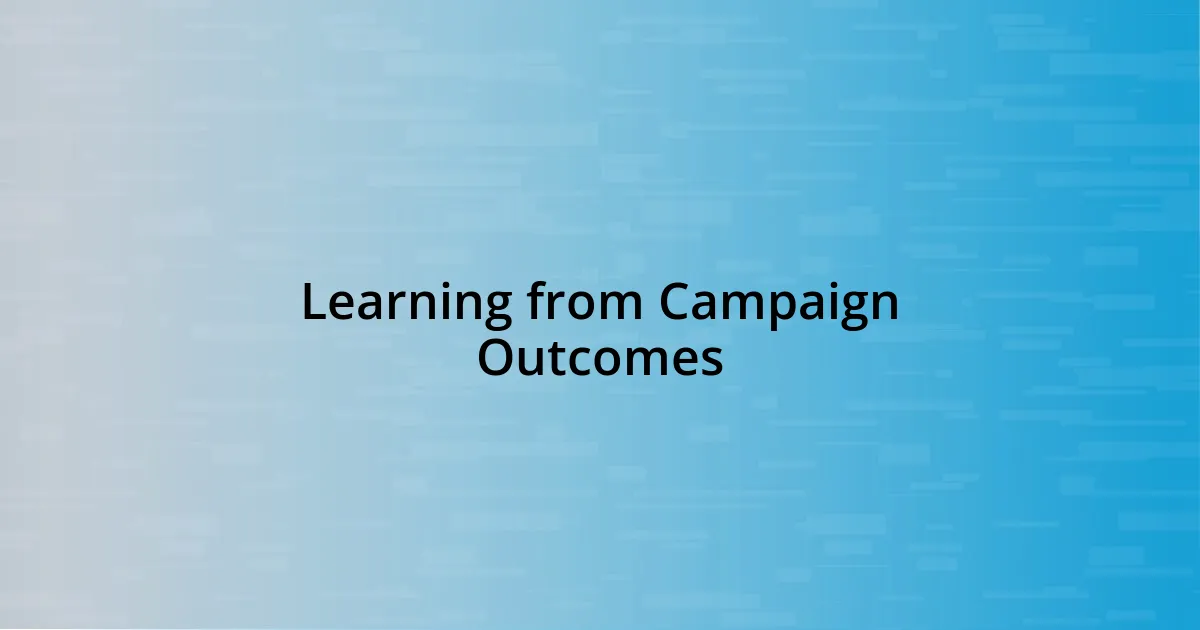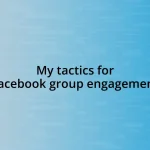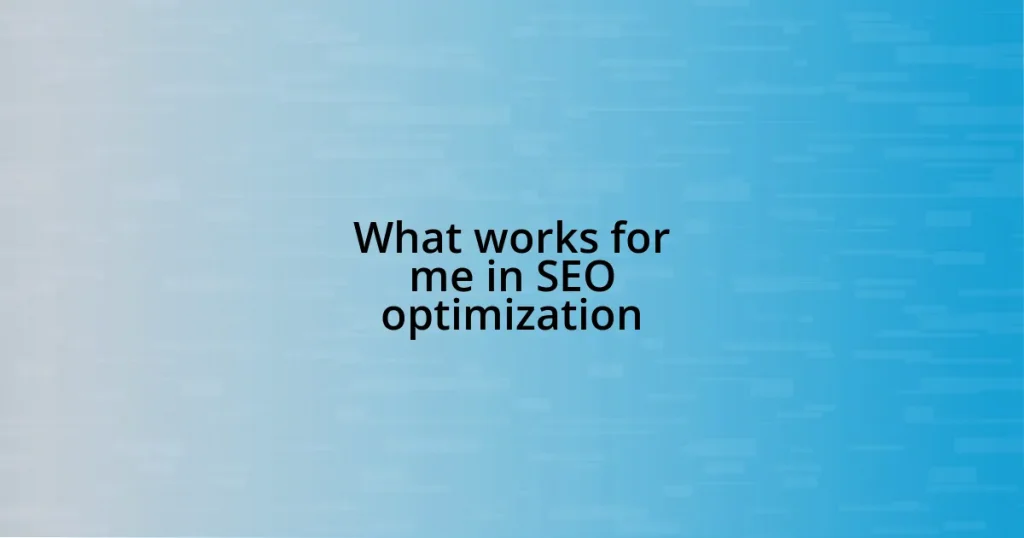Key takeaways:
- Defining clear marketing goals is essential for guiding strategies and measuring success.
- Understanding and identifying the target audience through research and engagement leads to more effective campaigns.
- Crafting compelling messages that resonate emotionally and using simple language can significantly enhance audience engagement.
- Adapting strategies based on data insights, including performance metrics and customer feedback, is crucial for improving outcomes.

Understanding My Marketing Goals
Understanding my marketing goals is crucial to the success of my campaigns. Early in my career, I remember launching a product without defining clear objectives. It was a frustrating experience; I thought, “What was the point of all this effort?” This taught me that without knowing exactly what I want to achieve—whether it’s building brand awareness, increasing sales, or engaging more with customers—it’s like shooting an arrow without a target.
I often reflect on how different goals impact my strategies. For instance, when I aimed to grow my social media following, I focused on sharing valuable content and engaging directly with my audience. This approach not only expanded my reach but deepened my relationship with my followers. Have you ever noticed how the clarity of a goal can shape your tactics? When the goal is defined, everything else falls into place.
Moreover, I’ve learned that setting measurable goals keeps me accountable. I vividly recall a campaign where I aimed to boost email sign-ups by 50%. Tracking my progress daily kept me motivated and pushed me to refine my approach. It made me realize that specific, quantifiable goals are essential—they guide my decisions and provide a sense of accomplishment when I hit those milestones. What about you? Have measurable goals changed your perspective on your marketing efforts?

Identifying Target Audience Effectively
Identifying my target audience has been a game changer in my marketing campaigns. I remember a time when I miscalculated who would resonate with my product, leading to wasted resources and low engagement. After that experience, I made it a priority to dive deep into demographics, psychographics, and behaviors to understand exactly who I was talking to. It’s fascinating how getting to know my audience not only improved my campaign results but also made me feel more connected to them.
To effectively identify your target audience, consider these steps:
– Conduct Market Research: Utilize surveys or focus groups to gather insights directly from potential customers.
– Analyze Customer Data: Look at existing customer profiles to find patterns in purchasing behavior and preferences.
– Develop Buyer Personas: Create fictional characters that represent your ideal customers, incorporating age, interests, and pain points.
– Monitor Trends: Keep an eye on industry trends and adjust your audience understanding accordingly.
– Engage with Your Audience: Don’t hesitate to ask for feedback through social media or email; their responses are invaluable.
Reflecting on these methods has helped me tailor my campaigns with precision, driving not just sales but rich, meaningful connections. It’s this understanding of who they are and what they want that truly fuels my passion for marketing.

Crafting Compelling Campaign Messages
Crafting compelling campaign messages is an art that requires a deep understanding of both the audience and the core message. I vividly remember a campaign where I struggled to convey the unique benefits of a new service. I spent numerous hours brainstorming, only to realize that I was missing a crucial emotional connection. Once I shifted my focus to telling a story that resonated with my audience’s experiences, the response was overwhelmingly positive. It’s remarkable how a narrative can transform a dry message into something truly relatable and engaging.
One of the key elements I’ve found effective in crafting messages is using simple language while still maintaining a powerful impact. I once experimented with a campaign that focused on using terminology familiar to my audience, rather than industry jargon. This small change resulted in higher engagement rates because people felt like they were being spoken to, rather than at. Have you ever thought about how your choice of words affects your audience’s perception? I believe that when we communicate clearly and authentically, we invite our audience into our narrative.
Additionally, incorporating a strong call to action (CTA) has proven to be essential in my campaigns. I recall a time when I launched a new product, and instead of a simple “Buy Now,” I asked my audience to “Join the Movement” associated with the product. Not only did this create a sense of community and urgency, but it also encouraged a deeper connection with the brand. It’s essential to frame your messages in a way that inspires action and invites people to become part of something bigger.
| Message Element | Description |
|---|---|
| Emotional Connection | Using narratives that resonate with the audience’s experiences. |
| Language Simplicity | Choosing familiar terms over jargon to foster engagement. |
| Strong CTA | Encouraging audience participation through compelling calls to action. |

Selecting Appropriate Marketing Channels
Selecting the right marketing channels can feel like navigating a maze. I often reflect on a campaign where I struggled to figure out where to allocate my budget effectively. In the end, I realized that understanding where my audience spends their time was crucial. For instance, I used to favor traditional media, but quickly found that social platforms were where my message truly resonated. Have you ever invested in a channel that didn’t perform as expected? It can be frustrating, but it taught me the value of adaptability.
I also learned that testing different channels is vital. I remember launching a product and splitting my budget between email marketing and social media ads. Initially, I thought my audience would respond better to emails because they seemed like a more professional option. However, the social media ads not only reached a wider audience but also encouraged engagement in ways I hadn’t anticipated. I’m often amazed at how a little experimentation can lead to breakthroughs in understanding where your marketing efforts will truly pay off.
With technology constantly evolving, keeping an open mind is key. I made it a habit to attend webinars and explore new tools that could enhance my channel selection process. For example, incorporating analytics tools helped me track which channels were delivering results. Does your current strategy leverage data insights? I believe embracing technology provides a competitive edge, helping you refine your approach to exactly what works for your audience.

Measuring Campaign Performance Accurately
One of the most enlightening experiences I’ve had in measuring campaign performance was during a product launch. I remember eagerly awaiting the results from my first digital campaign while using multiple metrics—click-through rates, engagement levels, and conversion ratios. I discovered that while high engagement rates were a joy, they didn’t necessarily translate to sales. This realization pushed me to rely on a more holistic approach that combined quantitative data with qualitative feedback, emphasizing that numbers alone can’t depict the complete story.
In another instance, I used A/B testing to compare two different email subject lines. Initially, I thought the catchier option would perform better, but I was surprised when the more straightforward subject line yielded higher open rates. It’s moments like these that really teach you the essence of understanding your audience deeply. Have you ever found yourself second-guessing your instincts after seeing unexpected results? I believe it’s crucial to embrace such surprises, as they often lead to valuable insights that can enhance future campaigns.
Ultimately, setting clear, measurable objectives is a game-changer. I once stumbled through a campaign without a defined goal, resulting in a muddled performance analysis. After that failed effort, I committed to establishing specific KPIs (Key Performance Indicators) for each campaign. This practice not only clarified my focus but also allowed for better tracking. Ever noticed how clear goals can energize your entire strategy? I’ve come to understand that when you know exactly what success looks like, it transforms the way you measure performance.

Adapting Strategies Based on Data
When it comes to adapting strategies based on data, I’ve learned that staying agile is crucial. Recently, I analyzed the performance of a Facebook ad campaign that was underperforming. I took a deep breath and decided to pivot my messaging, focusing more on storytelling rather than just pushing a sale. In the end, the refreshed approach not only garnered more clicks but also sparked conversations that I didn’t expect. Isn’t it fascinating how a shift in strategy can breathe new life into a campaign?
A specific instance that stands out for me involved tracking user behavior on my website. At one point, I noticed a significant drop-off at a particular stage in the customer journey. Initially, it was disheartening to see these numbers, but it prompted me to investigate further. I discovered that my call-to-action wasn’t as compelling as I thought. By adjusting the language and making it more action-oriented, I saw a drastic improvement in engagement. I always find it interesting how data can serve as a guide, leading us to uncover hidden opportunities.
I believe that gathering data is just the beginning; the real magic happens when you start interpreting it. For instance, I once explored sentiment analysis from social media feedback, which revealed how my audience felt about my brand compared to a competitor. This insight was invaluable—it urged me to adjust my messaging to address specific pain points and desires of my audience. Have you ever tapped into your audience’s emotions through data? I find that understanding the ‘why’ behind the numbers shapes a more authentic and effective marketing strategy.

Learning from Campaign Outcomes
Reflecting on campaign outcomes has transformed my approach to marketing. After launching a rebranding campaign, I was eager to analyze its impact. To my surprise, metrics showed an increase in website traffic, but the sales didn’t budge. This disconnection made me realize that success isn’t just counting numbers but understanding what those numbers truly represent. Have you ever felt this gap in your results? I learned that diving deeper into customer feedback is essential for crafting campaigns that resonate.
Another time, I experimented with content personalization in an email blast. While the open rates were encouraging, I noticed a drop-off in click-through rates. This prompted me to analyze the content context: were we speaking their language? I reworked the messaging to include more relatable stories and saw a significant uptick in engagement. It taught me that even when you feel confident about a direction, there’s always room for adjustment based on real-time outcomes.
One of the most eye-opening experiences was conducting a post-campaign survey. I really connect with my audience when they share their perspectives. The insights I gained weren’t just enlightening; they were transformational. A single piece of feedback revealed why one demographic felt disconnected from my offerings. This prompted me to re-evaluate my target segments completely. Don’t you think that listening to your audience can lead to unexpected revelations? I’ve found those conversations often provide the clarity needed to refine future campaign strategies effectively.















